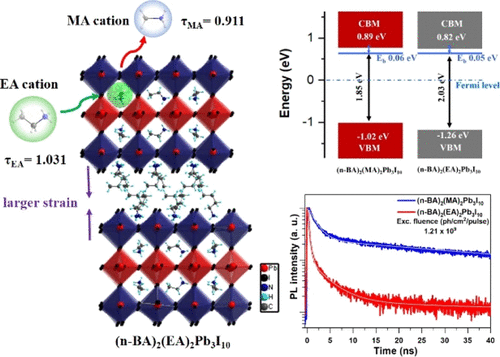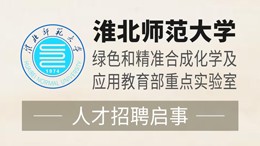当前位置:
X-MOL 学术
›
ACS Appl. Energy Mater.
›
论文详情
Our official English website, www.x-mol.net, welcomes your feedback! (Note: you will need to create a separate account there.)
Electronic Structure and Trap States of Two-Dimensional Ruddlesden–Popper Perovskites with the Relaxed Goldschmidt Tolerance Factor
ACS Applied Energy Materials ( IF 5.4 ) Pub Date : 2020-04-23 00:00:00 , DOI: 10.1021/acsaelm.0c00179 Mingli Liang 1 , Weihua Lin 2 , Zhenyun Lan 3 , Jie Meng 1 , Qian Zhao 1 , Xianshao Zou 2 , Ivano E. Castelli 3 , Tönu Pullerits 2 , Sophie E. Canton 4 , Kaibo Zheng 1, 2
ACS Applied Energy Materials ( IF 5.4 ) Pub Date : 2020-04-23 00:00:00 , DOI: 10.1021/acsaelm.0c00179 Mingli Liang 1 , Weihua Lin 2 , Zhenyun Lan 3 , Jie Meng 1 , Qian Zhao 1 , Xianshao Zou 2 , Ivano E. Castelli 3 , Tönu Pullerits 2 , Sophie E. Canton 4 , Kaibo Zheng 1, 2
Affiliation

|
Two-dimensional Ruddlesden–Popper perovskites (2D RPPs) have been considered as promising building blocks for optoelectronic applications owing to optical properties comparable to the ones of 3D perovskites, together with superior stability. In addition, the more flexible structure adopted by such perovskites leads to a relaxation of the Goldschmidt tolerance factor (τ) requirement. Herein, we compare the crystalline and electronic structures, as well as the photophysics of two 2D perovskite single crystals (n-BA)2(MA)2Pb3I10 (BMAPI) and (n-BA)2(EA)2Pb3I10 (BEAPI) (n-BA = n-butylamine) containing small A-cations (MA, methylammonium) and large A-cations (EA, ethylammonium), respectively. The latter presents a relaxed τ (τEA > 1) compared with the requirement of a stable phase in 3D perovskites (τ < 1). Such relaxed τ is beneficial from the structural flexibility of the long organic cation bilayer and the pronounced lattice distortions in the 2D perovskite structures. We further elucidate how the greater lattice distortions concurrently modulate the electronic structure as well as trap densities in these 2D RPPs. The electronic band gap (Eg) of BEAPI (2.08 ± 0.03 eV) is ∼0.17 eV larger than the one of BMAPI (1.91 ± 0.03 eV). This is mainly because of a shift in the valence band maximum associated with the expansion of the Pb–I bond length in BEAPI. In addition, the overall trap state densities for BMAPI and BEAPI are calculated to be ∼2.18 × 1016 and ∼3.76 × 1016 cm–3, respectively, as extracted from the time-resolved photoluminescence studies. The larger trap density in BEAPI can be attributed to the stronger interfacial lattice distortion that sets in when large EA cations are contained into the inorganic crystal lattice.
中文翻译:

具有松弛Goldschmidt宽容因子的二维Ruddlesden-Pop钙钛矿的电子结构和陷阱态
二维Ruddlesden–Popper钙钛矿(2D RPP)由于具有可与3D钙钛矿相媲美的光学特性,因此被认为是光电子应用的有前途的构建基块。另外,这种钙钛矿采用的更柔性的结构导致戈德施密特公差因子(τ)要求的放松。在这里,我们比较了两个2D钙钛矿单晶(n -BA)2(MA)2 Pb 3 I 10(BMAPI)和(n -BA)2(EA)2 Pb的晶体和电子结构,以及光物理性质3 I 10(BEAPI)(n-BA =正丁胺)分别包含小的A-阳离子(MA,甲基铵)和大的A-阳离子(EA,乙基铵)。后者呈现松弛τ(τ EA > 1)与稳定相的钙钛矿3D的要求(τ<1)进行比较。这种松弛的τ受益于长有机阳离子双层的结构柔性和2D钙钛矿结构中明显的晶格畸变。我们进一步阐明更大的晶格畸变如何同时调节这些2D RPP中的电子结构以及陷阱密度。电子带隙(E g)的BEAPI(2.08±0.03 eV)比BMAPI的其中一个(1.91±0.03 eV)大〜0.17 eV。这主要是由于与BEAPI中Pb–I键长度的扩展相关的价带最大值的移动。另外,从时间分辨光致发光研究中提取出的BMAPI和BEAPI的总陷阱态密度分别为〜2.18×10 16和〜3.76×10 16 cm –3。BEAPI中较大的陷阱密度可归因于当较大的EA阳离子包含在无机晶格中时产生的较强的界面晶格畸变。
更新日期:2020-04-23
中文翻译:

具有松弛Goldschmidt宽容因子的二维Ruddlesden-Pop钙钛矿的电子结构和陷阱态
二维Ruddlesden–Popper钙钛矿(2D RPP)由于具有可与3D钙钛矿相媲美的光学特性,因此被认为是光电子应用的有前途的构建基块。另外,这种钙钛矿采用的更柔性的结构导致戈德施密特公差因子(τ)要求的放松。在这里,我们比较了两个2D钙钛矿单晶(n -BA)2(MA)2 Pb 3 I 10(BMAPI)和(n -BA)2(EA)2 Pb的晶体和电子结构,以及光物理性质3 I 10(BEAPI)(n-BA =正丁胺)分别包含小的A-阳离子(MA,甲基铵)和大的A-阳离子(EA,乙基铵)。后者呈现松弛τ(τ EA > 1)与稳定相的钙钛矿3D的要求(τ<1)进行比较。这种松弛的τ受益于长有机阳离子双层的结构柔性和2D钙钛矿结构中明显的晶格畸变。我们进一步阐明更大的晶格畸变如何同时调节这些2D RPP中的电子结构以及陷阱密度。电子带隙(E g)的BEAPI(2.08±0.03 eV)比BMAPI的其中一个(1.91±0.03 eV)大〜0.17 eV。这主要是由于与BEAPI中Pb–I键长度的扩展相关的价带最大值的移动。另外,从时间分辨光致发光研究中提取出的BMAPI和BEAPI的总陷阱态密度分别为〜2.18×10 16和〜3.76×10 16 cm –3。BEAPI中较大的陷阱密度可归因于当较大的EA阳离子包含在无机晶格中时产生的较强的界面晶格畸变。






































 京公网安备 11010802027423号
京公网安备 11010802027423号